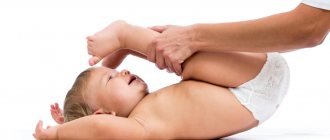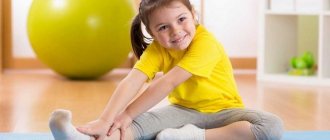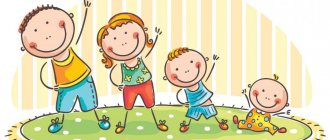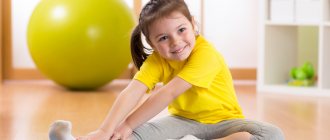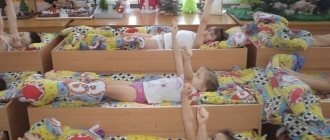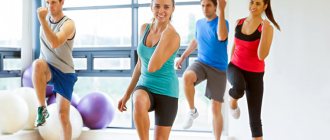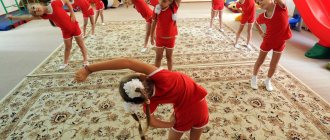The meaning of exercises to music in kindergarten
Irina Narozhneva
The meaning of exercises to music in kindergarten
Guidelines for conducting musical exercises in preschool educational institutions
Traditionally, the daily routine in kindergarten includes morning exercises. It is held between the reception of children in preschool and breakfast. It is unacceptable to neglect exercise , because this is an important component of the motor activity of preschoolers. Regularly performing gymnastic exercises in the first half of the day helps improve overall health and stimulates the body's protective functions.
Ideally, general strengthening exercises are carried out immediately after waking up. However, the rhythm of modern life does not always allow parents to exercise with their children at home . Awakening gymnastics is possible only in 24-hour kindergartens , where preschoolers stay 5 days a week. This kind of exercise allows you to gently wake up the body, increase muscle tone and get kids into a working mood. Gymnastic exercises after sleep help the body quickly tone up. The older generation remembers well how in the morning the melody of the pioneer dawn called children all over the country to line up for exercise . The exercises were performed with musical accompaniment according to the clear instructions of the announcer. In Soviet times, similar gymnastic complexes were included in the daily routine of kindergartens and health camps. These blocks of exercises to music have now been revised and supplemented with gaming and developmental techniques.
Doing exercises in the morning puts preschoolers in a working mood. Why is it recommended to do exercises in kindergarten accompanied by music ? The soundtrack, at first glance, entertains the guys. Most of the melodies and songs for morning exercises are in a major scale and really evoke positive emotions in children. At the same time, the use of musical accompaniment helps in solving many organizational and developmental problems.
Functions of musical accompaniment of morning exercises
performs a number of functions when doing exercises in kindergarten
• Signal to start and end exercises. The melody helps children figure out when to start moving and when to stop. It can be difficult for younger preschoolers to navigate the verbal command of the instructor, so all movements during exercises with pupils 1.5–4 years old are performed to music .
• Determining the tempo of exercise : marching, running, jumping, bending, turning, swinging. The group must perform movements synchronously. It is easier for children to focus on the rhythm than on the movements of their classmates. You won’t get lost while walking if you step to the rhythm of the sounding march.
• Indication of the nature of the exercises. A slow melody implies smooth movements, a fast melody implies rhythmic actions. Music promotes expressive exercise ; children strive to do exercises not mechanically, but emotionally.
• Development of musical abilities . Music accompanies children in various classes and events in kindergarten . Pupils learn to listen and understand melodies and songs in classes with a music director , during preparation for matinees, at themed leisure activities, in the theater corner. The ability to perceive the beauty of music comes gradually . Audio exercises develop in children a sense of rhythm and the ability to recognize the emotional intonations of a melody and their shades.
• Therapeutic effect. Listening to music creates a cheerful mood, prevents overwork and the emergence of negative emotions.
This is interesting. Listening to music , among other things, has a positive effect on the development of the intellectual abilities of preschoolers.
Doing physical exercises while listening to fun music makes kids smile and feel happy.
Morning exercises are carried out in a pre-ventilated room: in a group, sports hall or music hall . The teacher and children wear comfortable clothes and shoes, preferably a set for physical education (girls can wear gymnastic swimsuits)
.
In the warm season, exercises outside: on a group site or sports ground.
For physical and dance training, you need to wear sportswear - it is comfortable and aesthetically pleasing.
Musical compositions are selected for a full complex of exercises : introductory, main and final parts. It’s best when children practice to the accompaniment of a musical director . But this is impossible for daily practice: each group does exercises at the same time (before breakfast, and the music director and the hall are singular. Exercises and travel are carried out to the accompaniment of music , dance exercises , as well as an open exercise .
Exercises in the form of a journey or with the participation of fairy-tale characters to live accompaniment
Exercises carried out in an unusual form will help to quickly involve all students in the process of doing exercises and will set them up for further activities in kindergarten .
Songs and melodies are usually played on a tape recorder or stereo system . It is convenient to save audio tracks for charging in folders with the names of gymnastic complexes on your computer or laptop. Music should be clearly audible anywhere in the room; if necessary, the teacher connects audio speakers to the computer.
The instructor can use a record player and speakers for musical exercises . Use of ICT (information and communication/information and computer technologies)
welcome in the work of
kindergarten . During a morning exercise class, you can use an interactive board or canvas to display pictures (in thematic and story exercises , animation or other funny videos as a reminder of movements.
Each stage of exercise is accompanied by an audio recording of the appropriate tempo and melody:
•introductory stage: rhythmic music of moderate tempo activates children’s attention, a short warm-up is performed to it;
•main stage: songs and melodies of moderate and high tempo for performing general strengthening exercises and continuous running (at the end)
;
•completion: calm music for a sedentary game or breathing exercises.
Each charging must be accompanied by music of a certain tempo . The teacher compiles a card index of musical exercises . For each topic, the names of audio compositions and a list of exercises for them are indicated.
Some morning exercises to music (especially dance elements)
are performed with sound attributes: tambourines, rattles (homemade maracas, rattles, bells. During
exercises, musical instruments are used , which children are already familiar with playing. During the exercises, the skill of elementary music-making is trained - getting to the beat.
Exercises to music in the first junior group
Like all physical education activities, exercises to music in the first junior (nursery)
group has its own organizational features in accordance with the Federal State Educational Standard (FSES
) (Federal State Educational Standard)
:
• the duration of morning exercises is 4–5 minutes;
•it is recommended to use folklore texts: chants, chants, ditties;
• during the school year, various types of exercises ;
• exercises with children 1.5–3 years old are carried out to music and funny songs , mainly imitation movements and actions called in the song (imitative movements)
.
Short musical compositions help kids understand the image whose movements they will imitate in the exercise. For example, the children will have to show how a kitten moves its paws, releases its claws, and catches toys. Song based on the words of the poem “Tsap-scratch”
(
“The kitten’s paws are soft pillows”
) R. Aldonina tells the kids that at the beginning of the exercise the movements should be smooth and then sharp.
Musical and play gymnastics
Irina Ilchevskaya
Musical and play gymnastics
Usually the teacher gives the music director a set of morning exercises , and he selects music for all the basic movements and exercises. Children then perform these exercises, imitating the rhythm of the music . But one day I decided to change the traditional exercises to a more interesting option, so that the children would enjoy such exercises and charge them with positive energy for the whole day. Somehow I came across a text where natural phenomena, the habits of animals, domestic animals, birds, and insects were described in poetic form. I started reading the text and music , like a background for the poetic lines. It was a well-known melody from the program “In the Animal World”
.
I myself didn’t notice how enthusiastically I was performing the movements according to the text to this beautiful melody. Next, I offered the teacher my version of gymnastics , introduced him to the content, and now, together with the children, we brought the idea to life. You should have seen how the kids’ eyes lit up, with what pleasure they performed everything expressively, the joy knew no bounds. The complex turned into a musical game with characteristic movements. A new form of morning exercises helps children get into character, turn on their imagination, transform into one or another character according to the text, as well as relieve muscle tension and loosen up.
In the future, it will be easier and more interesting for the child to play role-playing games. I bring to your attention this unusual exercise-musical-game gymnastics for preschool children.
The sun is floating in the sky - raise your hands up
A strong wind bends the grass - shake it with your hands (breeze)
There is water babbling in the stream; hands in the castle we represent a wave.
The fox wags its tail - turns its body left and right
The elephant nods its head - we nod
The squirrel catches its tail - turns the body left and right with clapping
A young bunny jumps and gallops - jumping on two legs
The dog itches with its back leg - alternately bending the leg at the knee behind the other leg
The bear digs roots - the body bends towards the toes
Kvochka rakes the leaves - “we wipe the legs one by one on the floor”
A wild cat catches a fish - the body bends forward with a clap in front of itself
A duck is swimming in a river - squat down and sway left and right
The frog jumps quickly - frog jumping
The bunny pricked up his ears - show his ears to the top of his head
The butterfly sits quietly, stands up slowly, bends one leg (heron, hands on the belt
The fish is sleeping under water - put your palms together and move the snake in front of you
The worm arched your back - stand straight with your hands at the top and clasp your palms together
The hamster puffed out his cheeks - puff out his cheeks and... n. too
The clouds float quietly - sway the body left and right, feet shoulder-width apart, exhale and everyone says the last phrase together:
EVERYONE GROWS HEALTHY!
Maybe one of your colleagues will replace some of the movements or completely come up with something of their own - this is your imagination and creativity, and I just shared my idea with you. Take heart, my friends, because everything is created for our beloved students!
